2017 TOYOTA SIENNA tire pressure
[x] Cancel search: tire pressurePage 583 of 672
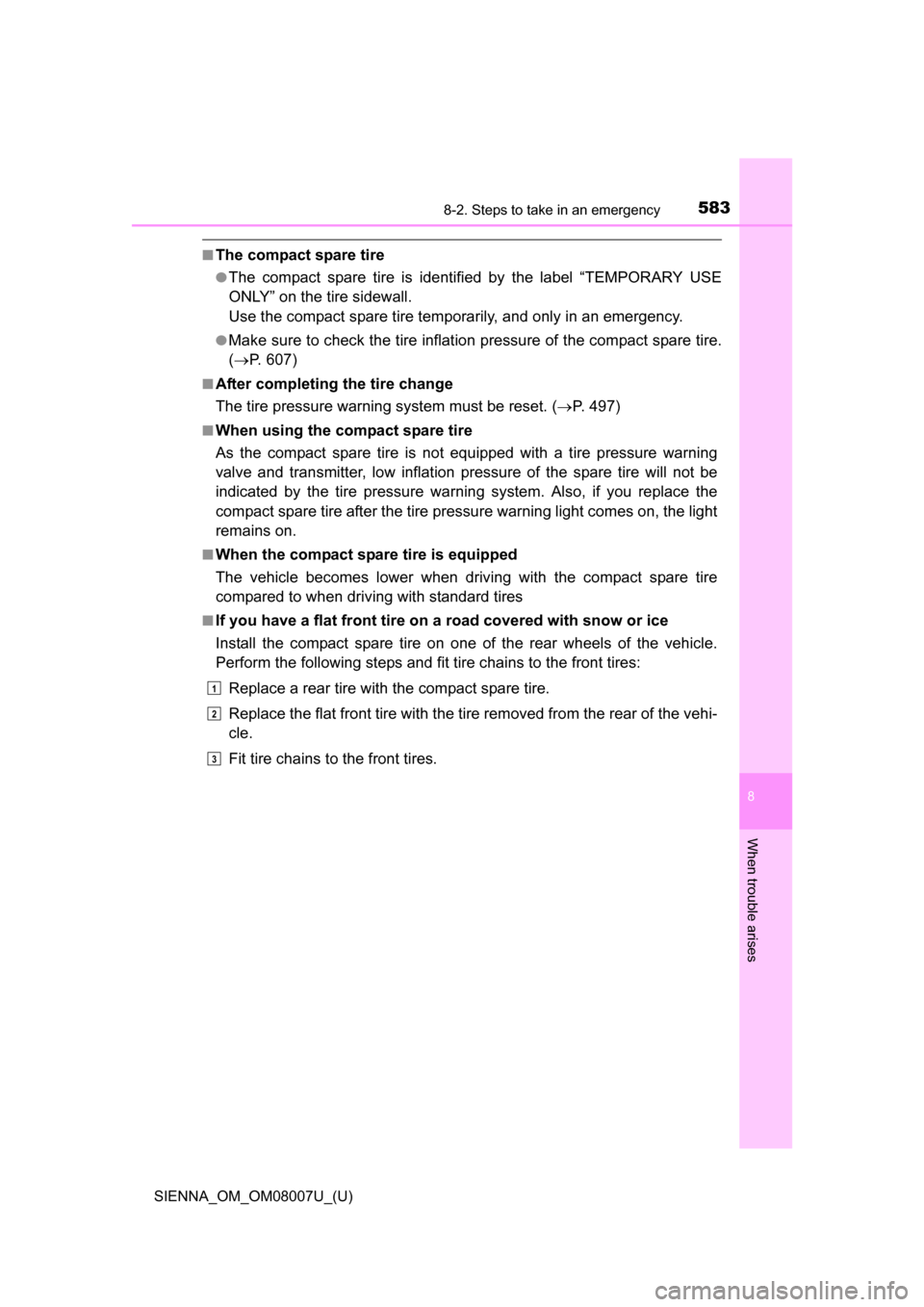
5838-2. Steps to take in an emergency
SIENNA_OM_OM08007U_(U)
8
When trouble arises
■The compact spare tire
●The compact spare tire is identified by the label “TEMPORARY USE
ONLY” on the tire sidewall.
Use the compact spare tire temporarily, and only in an emergency.
●Make sure to check the tire inflatio n pressure of the compact spare tire.
( P. 607)
■After completing the tire change
The tire pressure warning system must be reset. ( P. 497)
■When using the compact spare tire
As the compact spare tire is not equipped with a tire pressure warning
valve and transmitter, lo w inflation pressure of the spare tire will not be
indicated by the tire pressure warning system. Also, if you replace the
compact spare tire after the tire pressure warning light comes on, the light
remains on.
■When the compact spare tire is equipped
The vehicle becomes lower when driving with the compact spare tire
compared to when driving with standard tires
■If you have a flat front tire on a road covered with snow or ice
Install the compact spare tire on one of the rear wheels of the vehicle.
Perform the following steps and fit tire chains to the front tires:
Replace a rear tire with the compact spare tire.
Replace the flat front tire with the tire removed from the rear of the vehi-
cle.
Fit tire chains to the front tires.
1
2
3
Page 585 of 672

5858-2. Steps to take in an emergency
SIENNA_OM_OM08007U_(U)
8
When trouble arises
NOTICE
■When loosening or tightening the spare tire clamp bolt
Do not use an impact wrench. Use the adapter socket and jack handle.
■Be careful when driving over bumps with the compact spare tire
installed on the vehicle
The vehicle becomes lower when driving with the compact spare tire
compared to when driving with standard tires. Be careful when driving
over uneven road surfaces.
■Driving with tire chains and the compact spare tire
Do not fit tire chains to the compact spare tire.
Tire chains may damage the vehicle body and adversely affect driving
performance.
■When replacing the tires
When removing or fitting the wheels, tires or the tire pressure warning
valve and transmitter, contact your Toyota dealer as the tire pressure
warning valve and transmitter may be damaged if not handled correctly.
■To avoid damage to the tire pressure warning valves and transmit-
ters
When a tire is repaired with liquid sealants, the tire pressure warning
valve and transmitter may not operate properly. If a liquid sealant is
used, contact your Toyota dealer or other qualified service shop as soon
as possible. Make sure to replace the tire pressure warning valve and
transmitter when replacing the tire. ( P. 497)
■After taking out or stowing the spare tire
Make sure to secure the tire carrier by tightening the clamp bolt to pre-
vent the holding bracket from hitting the under body of the vehicle dur-
ing driving.
■Using the tire carrier
●As the tire carrier is designed for use with the compact spare tire, it
cannot be used with standard tires.
●If the spare tire is flat, do not use t he tire carrier, as the tire may not be
held securely.
Page 606 of 672

606
SIENNA_OM_OM08007U_(U)
9-1. Specifications
*1: Minimum pedal clearance when depressed with a force of 110 lbf (490 N,50 kgf) while the engine is running
*2: Parking brake pedal travel when depressed with a force of 67.4 lbf (300 N,30.6 kgf)
17-inch tires
18-inch tires
Brakes
Pedal clearance*12.99 in. (76 mm)
Pedal free play 0.04 0.24 in. (1 6 mm)
Brake pad wear limit0.04 in. (1.0 mm)
Parking brake lining wear limit 0.04 in. (1.0 mm)
Parking brake pedal travel*23 6 clicks
Fluid type SAE J1703 or FMVSS No.116 DOT 3
Steering
Free play Less than 1.2 in. (30 mm)
Tires and wheels
Tire sizeP235/60R17 100T
Tire inflation pressure
(Recommended cold tire
inflation pressure)Front:
35 psi (240 kPa, 2.4 kgf/cm2 or bar)
Rear:
35 psi (240 kPa, 2.4 kgf/cm
2 or bar)
Wheel size 17 x 7J
Wheel nut torque76 ft•lbf (103 N•m, 10.5 kgf•m)
Tire size 235/55R18 100V, 235/55RF18 100T
Tire inflation pressure
(Recommended cold tire
inflation pressure)Front:
36 psi (250 kPa, 2.5 kgf/cm2 or bar)
Rear:
36 psi (250 kPa, 2.5 kgf/cm
2 or bar)
Wheel size 18 x 7J
Wheel nut torque76 ft•lbf (103 N•m, 10.5 kgf•m)
Page 607 of 672
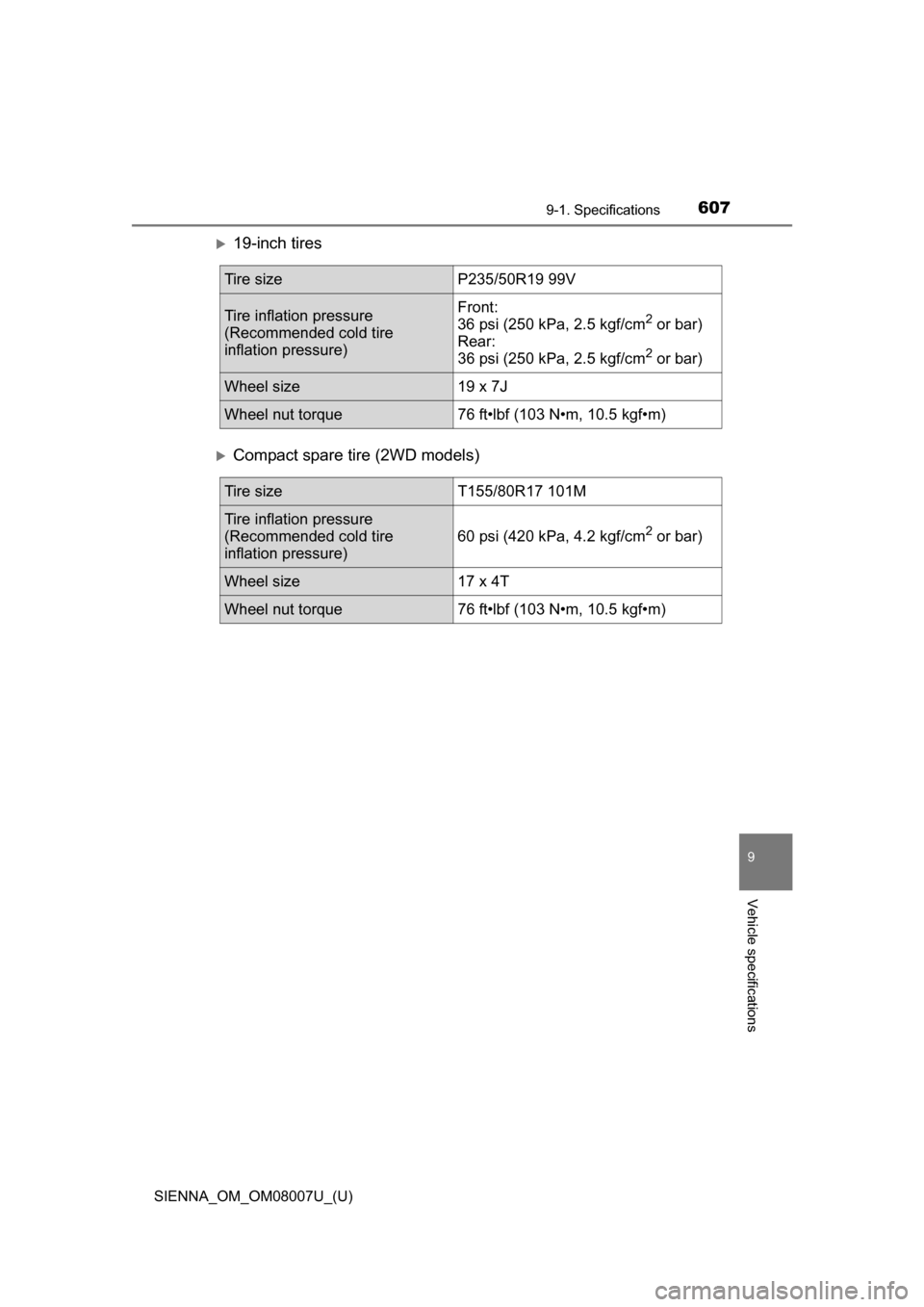
SIENNA_OM_OM08007U_(U)
6079-1. Specifications
9
Vehicle specifications
19-inch tires
Compact spare tire (2WD models)
Tire sizeP235/50R19 99V
Tire inflation pressure
(Recommended cold tire
inflation pressure)Front:
36 psi (250 kPa, 2.5 kgf/cm2 or bar)
Rear:
36 psi (250 kPa, 2.5 kgf/cm
2 or bar)
Wheel size 19 x 7J
Wheel nut torque76 ft•lbf (103 N•m, 10.5 kgf•m)
Tire size T155/80R17 101M
Tire inflation pressure
(Recommended cold tire
inflation pressure)60 psi (420 kPa, 4.2 kgf/cm2 or bar)
Wheel size
17 x 4T
Wheel nut torque76 ft•lbf (103 N•m, 10.5 kgf•m)
Page 613 of 672
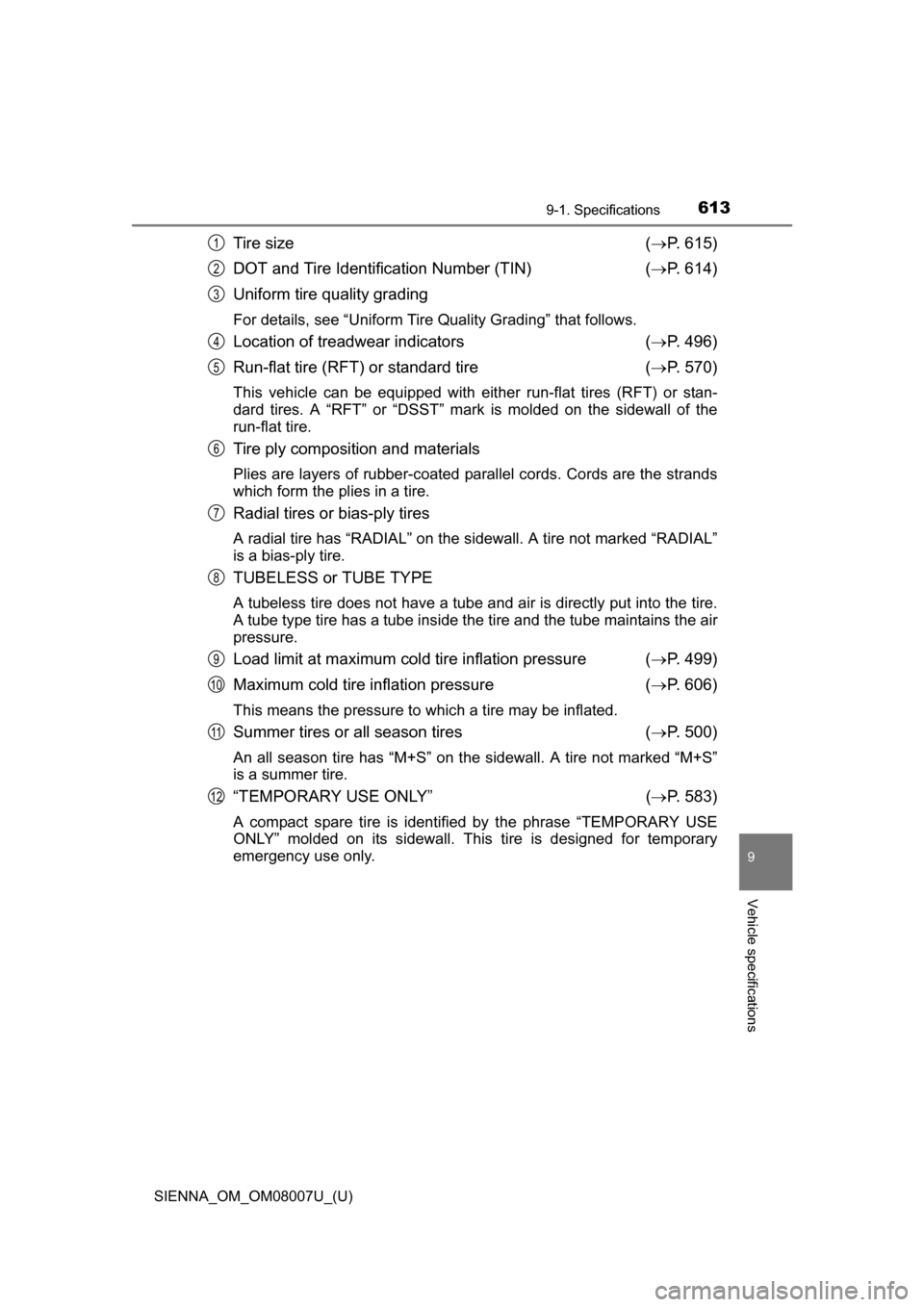
SIENNA_OM_OM08007U_(U)
6139-1. Specifications
9
Vehicle specifications
Tire size( P. 615)
DOT and Tire Identification Number (TIN) ( P. 614)
Uniform tire quality grading
For details, see “Uniform Tire Quality Grading” that follows.
Location of treadwear indicators ( P. 496)
Run-flat tire (RFT) or standard tire ( P. 570)
This vehicle can be equipped with ei ther run-flat tires (RFT) or stan-
dard tires. A “RFT” or “DSST” mark is molded on the sidewall of the
run-flat tire.
Tire ply composition and materials
Plies are layers of rubber-coated parallel cords. Cords are the strands
which form the plies in a tire.
Radial tires or bias-ply tires
A radial tire has “RADIAL” on the sidewall. A tire not marked “RADIAL”
is a bias-ply tire.
TUBELESS or TUBE TYPE
A tubeless tire does not have a tube and air is directly put into the tire.
A tube type tire has a tube inside the tire and the tube maintains the air
pressure.
Load limit at maximum cold tire inflation pressure ( P. 499)
Maximum cold tire inflation pressure ( P. 606)
This means the pressure to which a tire may be inflated.
Summer tires or all season tires ( P. 500)
An all season tire has “M+S” on the sidewall. A tire not marked “M+S”
is a summer tire.
“TEMPORARY USE ONLY” ( P. 583)
A compact spare tire is identified by the phrase “TEMPORARY USE
ONLY” molded on its sidewall. This tire is designed for temporary
emergency use only.
1
2
3
4
5
6
7
8
9
10
11
12
Page 618 of 672
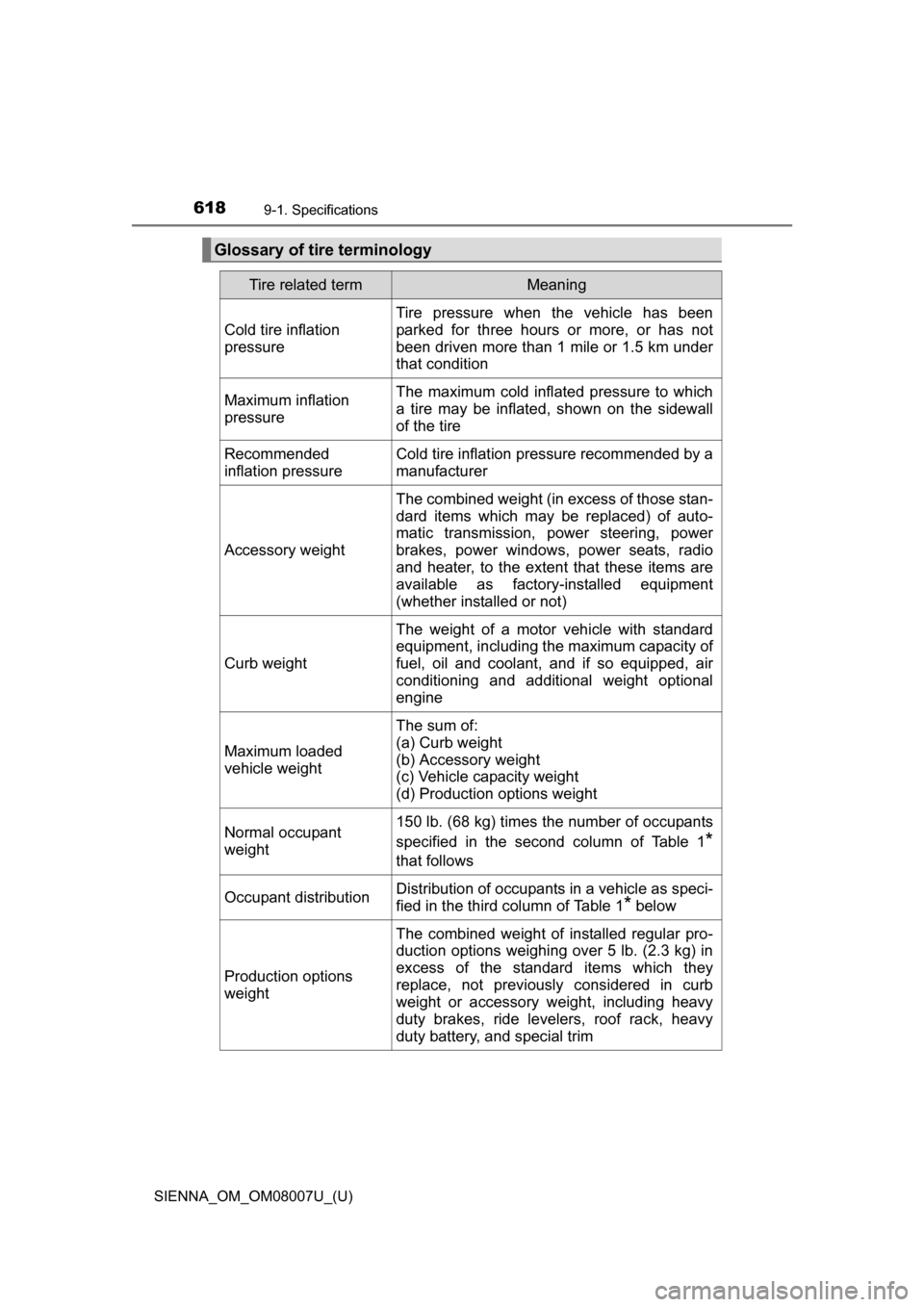
618
SIENNA_OM_OM08007U_(U)
9-1. Specifications
Glossary of tire terminology
Tire related termMeaning
Cold tire inflation
pressure Tire pressure when the vehicle has been
parked for three hours or more, or has not
been driven more than 1 mile or 1.5 km under
that condition
Maximum inflation
pressure The maximum cold inflat
ed pressure to which
a tire may be inflated, shown on the sidewall
of the tire
Recommended
inflation pressure Cold tire inflation pressure recommended by a
manufacturer
Accessory weight The combined weight (in excess of those stan-
dard items which may be replaced) of auto-
matic transmission, power steering, power
brakes, power windows, power seats, radio
and heater, to the extent
that these items are
available as factory-installed equipment
(whether installed or not)
Curb weight The weight of a motor vehicle with standard
equipment, including the maximum capacity of
fuel, oil and coolant, and if so equipped, air
conditioning and additional weight optional
engine
Maximum loaded
vehicle weight The sum of:
(a) Curb weight
(b) Accessory weight
(c) Vehicle capacity weight
(d) Production options weight
Normal occupant
weight 150 lb. (68 kg) times the number of occupants
specified in the second column of Table 1
*
that follows
Occupant distribution Distribution of occupants in a vehicle as speci-
fied in the third column of Table 1
* below
Production options
weight The combined weight of installed regular pro-
duction options weighing over 5 lb. (2.3 kg) in
excess of the standard items which they
replace, not previously considered in curb
weight or accessory weight, including heavy
duty brakes, ride levelers, roof rack, heavy
duty battery, and special trim
Page 620 of 672
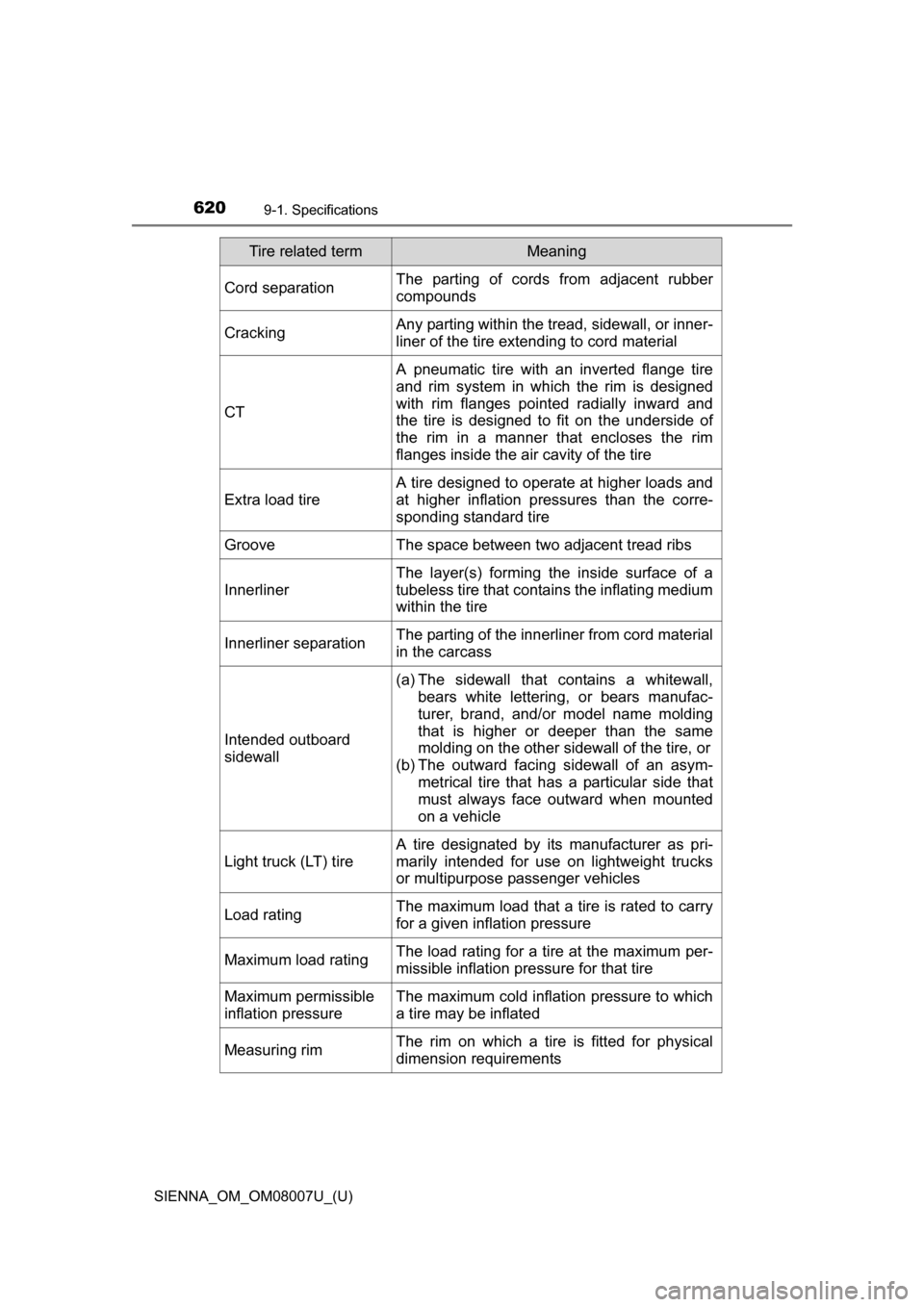
620
SIENNA_OM_OM08007U_(U)
9-1. Specifications
Cord separationThe parting of cords from adjacent rubber
compounds
Cracking Any parting within the tread, sidewall, or inner-
liner of the tire ext
ending to cord material
CT A pneumatic tire with an inverted flange tire
and rim system in which the rim is designed
with rim flanges pointed radially inward and
the tire is designed to fit on the underside of
the rim in a manner that encloses the rim
flanges inside the air cavity of the tire
Extra load tire A tire designed to operate at higher loads and
at higher inflation pressures than the corre-
sponding standard tire
Groove The space between two adjacent tread ribs
Innerliner The layer(s) forming the inside surface of a
tubeless tire that contains the inflating medium
within the tire
Innerliner separation The parting of the innerliner from cord material
in the carcass
Intended outboard
sidewall (a) The sidewall that contains a whitewall,
bears white lettering, or bears manufac-
turer, brand, and/or model name molding
that is higher or deeper than the same
molding on the other sidewall of the tire, or
(b) The outward facing sidewall of an asym-
metrical tire that has a particular side that
must always face outward when mounted
on a vehicle
Light truck (LT) tire A tire designated by its manufacturer as pri-
marily intended for use on lightweight trucks
or multipurpose passenger vehicles
Load rating The maximum load that a tire is rated to carry
for a given inflation pressure
Maximum load rating The load rating for a tire at the maximum per-
missible inflation pressure for that tire
Maximum permissible
inflation pressure The maximum cold inflat
ion pressure to which
a tire may be inflated
Measuring rim The rim on which a tire is fitted for physical
dimension requirements
Tire related termMeaning
Page 621 of 672

SIENNA_OM_OM08007U_(U)
6219-1. Specifications
9
Vehicle specifications
Open spliceAny parting at any junction of tread, sidewall,
or innerliner that extends to cord material
Outer diameter The overall diameter of an inflated new tire
Overall width The linear distance between the exteriors of
the sidewalls of an inflated tire, including ele-
vations due to labeling, decorations, or protec-
tive bands or ribs
Passenger car tire A tire intended for use on passenger cars,
multipurpose passenger vehicles, and trucks,
that have a gross vehicle weight rating
(GVWR) of 10,000 lb. or less
Ply A layer of rubber-coated parallel cords
Ply separation A parting of rubber compound between adja-
cent plies
Pneumatic tire A mechanical device made of rubber, chemi-
cals, fabric and steel or other materials, that,
when mounted on an automotive wheel, pro-
vides the traction and contains the gas or fluid
that sustains the load
Radial ply tire A pneumatic tire in which the ply cords that
extend to the beads are laid at substantially 90
degrees to the centerline of the tread
Reinforced tire A tire designed to operate at higher loads and
at higher inflation pressures than the corre-
sponding standard tire
Section width The linear distance between the exteriors of
the sidewalls of an inflated tire, excluding ele-
vations due to labeling, decoration, or protec-
tive bands
Sidewall That portion of a tire between the tread and
bead
Sidewall separation The parting of the rubber compound from the
cord material in the sidewall
Tire related termMeaning